
This past Tuesday through Friday, my father and I drove up to Big Sur country (the California coastline for about 75 miles south of Carmel and Monterey), mainly in search of wildflowers. In most years mid-April is prime wildflower season, but unfortunately for us some odd weather patterns have distorted the normal season. We did have some wildflowers (most especially ceanothus), but not the abundance we were hoping for. But despite the relative dearth of wildflowers — and some inclement weather — we had a wonderful time. Lots of photos and some more description “below the fold"…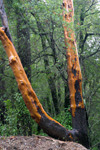
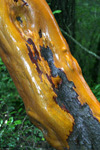
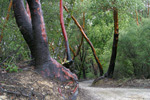
On our first full day in the Big Sur (Wednesday) it was raining all day long. Most of the time it was just hard enough to make a walk seem uncomfortable; sometimes it was pouring cats and dogs. And it was always wet out, so that if you walked through brush you’d be soaked. As a consequence, we only did a very little walking, and spent most of the day touring by car. We found a paved road (Namiciento Road) that crossed the coastal range, and took it all the way to the summit. At that point there was a reasonably good four-wheel road headed south along the summit ridge, so we took that — and ended up going about 15 miles through some very pretty country. For someone like me who’s used to the dry Southern California chaparral, this country looks like the rain forest — moss-covered tree trunks and an entirely different flora. Including these trees with odd, colorful bark: madrone.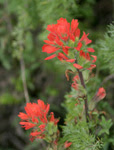
While we were driving along that ridge road, we could look down below at the coastline — and we saw the sun peeking out. That was enough to make us turn around and head for the shore at high speed, hoping we could get a little weather good enough for walking. And we did get just a little — perhaps a half-hour’s worth of decent weather before the rains came back.
We used that half-hour to climb a hillside that looked like it might have wildflowers on it. We saw a little weather-beaten ceanothus, and several very nice Indian paintbrushes like the one at right. The Indian paintbrush up here is a more intense, saturated crimson than any we have down in San Diego County; beautiful stuff…
And that was about it for our Wednesday — lots of beautiful scenery, viewed for the most part through a filter of haze and rain. We ended the day with a fine dinner at the restaurant that’s part of the Big Sur Lodge, where we stayed. It’s inside of the Pfeiffer Big Sur State Park, in a stately redwood grove; a very pleasant spot. The food was good, and plentiful. We goofed around in our room for a couple of hours with a roaring, crackling fire, and then toddled off to bed.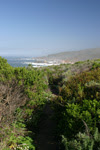
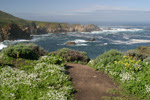
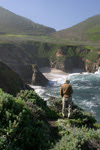
The next morning we had a very pleasant surprise: blue sky was visible over our heads! And in fact it stayed sunny and nearly cloudless all day long — not a drop of rain. A glorious spring day in Big Sur country!
After a nice breakfast at the Lodge, we headed north to Garrapata State Park. There’s a beautiful rocky coastline here, and that’s where we headed first. We had a very pleasant walk along the coastal bluffs, a mile or so of constantly changing scenes. The path winds through coastal scrubs of various sorts, and there were enough flowers out to add some color. The air was full of a clean ocean scent, and there was a continuous background sound of crashing waves. When we lifted our eyes from the ground, the blue Pacific Ocean and California sky filled our vision.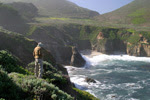
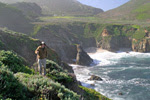
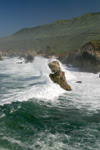
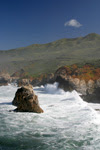
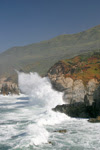

There were several vantage points along the bluffs where we stopped for a while to enjoy the crashing waves. Every few minutes there was a set of quite large waves smashing into the bluffs; some of them sent spray 50 feet or more up into the air. Each wave could be enjoyed multiple times, as the wave crashed onto rocks and outcroppings that were successively closer to shore. One particular outcropping (the leftmost picture in the lower row at right) acted sort of like a plow, cleaving each wave into a left and right segment. The air around it was full of spray, but the actual top of the outcropping was calm enough for seabirds to perch on. Each wave would obscure them from us, as the spray and foam shot up — and each time when the wave subsided, the birds were still calmly perched. It all looked quite improbable from our vantage point. One bluff’s shape, for whatever reason, caused the spray from each wave to shoot almost straight up (center photo on lower row), often rising well above the bluff. We hiked over to that bluff, and sat just a few feet from these great sea-foam geysers that it shot up…
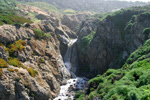

At the far right is a photo of a rocky beach, very common in this area. The incessant action of the waves rocks the stones back and forth, slowly shaping them into smooth ovoids. I was standing perhaps 100 feet from this beach as I took this photo, and even at that distance you could easily hear the chorus of thousands of rocks striking rocks as each wave receded. I’m sure that sound is also present when the wave first breaks, but the wave’s noise overwhelms the rocks, so you can’t hear it. The result is a very pleasant pattern of sound: an endless cycle of waves crashing, a kind of hiss as the wave flattens out against the beach, and then the random, slightly musical percussive symphony of the beach rocks as the wave recedes…
In this season there are thousands of small streams flowing out of the coast range. This one carves a typical little “canyon” as it descends, and over a series of small waterfalls as it makes its way down to the beach. In a few weeks this will most likely be a dry gully, but full of life as the plants make the most of the damp soil that was once a streambed…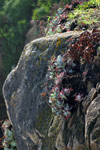
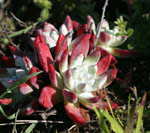
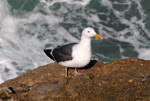
The fine fellow in the leftmost photo perched nonchalantly on the coastal rocks, along with three or four bazillion of his brethren. On many of those rocks the plant at far right also perches, often on cliffs and even undercuts. It is, I believe, a seedum (I’d need to see the flowers to be sure). This particular one has a very variable red varigation; some plants (but none I could get close to) were entirely red. While you can find this seedum out on a meadow, it seems to specialize in niches where only the boldest plants will go, such as the cliff-dweller I photographed at right. I saw some, from a distance, on outcroppings that were dripping with salt water (from spray), on undercuts of almost 45 degrees. I wonder how its seed gets to places like that? Perhaps it’s carried on the waves…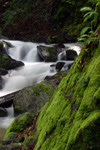
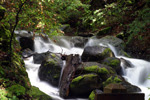
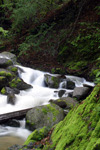
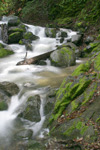
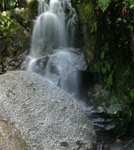
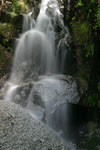
After we finished with our coastal walk, we headed off in search of another walk, this time in some forest where it was cooler (we got quite warm along the coast, in the bright sunshine). I found a road (Palo Colorado Road) that headed inland, up a canyon. We took the road mostly hoping it would get us to the forests that we could see high up in the coastal range — we didn’t expect the road itself to be very interesting. So it was an unexpected pleasure to discover that this road winds its way for 8 or 10 miles up a canyon that is a nearly continuous redwood grove. For nearly its entire length we were in deep shade, oxalis in bloom around us, along with forget-me-not and some others we didn’t know. Gorgeous! Much of the length was private land, with tiny (and often very run down) houses built on tiny little lots amongst the streamlets and redwood trunks. We found out later that these properties were worth at minimum $600K, and most well over $1M — you’d never think it, to look at most of them. But what a beautiful setting! On one tuck into a ravine, we happened across the waterfall I photographed at right. These are all time exposures, which accounts for the “fuzzy” appearance of the water…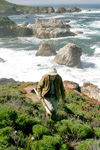
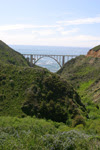
My father is in the photo at far right. For someone his age (82), he managed to get around quite well. But compared with his hiking adventures of years past, this was a very subdued, slow-paced trip. Certainly his enjoyment of the outdoors is undiminished, but the experience is very different for him now. Where he used to have the solid footing of a pack-mule, he’s now a little unsteady and finds a walking stick to be a big comfort. Where he once would have sprinted across a log bridge, he now moves carefully, slowly across it. Back in the day a twenty mile hike with several thousand feet of elevation change would have been a moderate day-hike; today a mile or two is the most he can manage. His sight is far less acute, his hearing practically gone were it not for hearing aids. All of that is hard for him, and hard for me to watch, giving rise to unwanted thoughts. Nonetheless I cherish this time, and I suspect he does as well…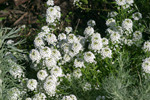
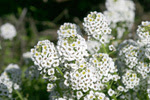
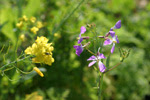
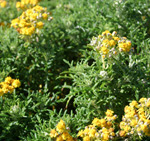
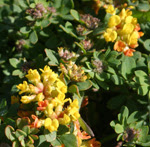
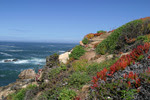

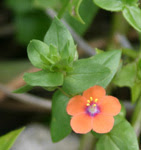
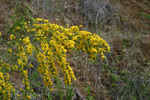
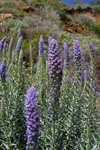
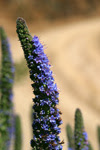
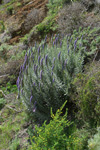
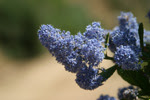
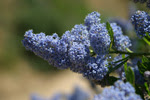
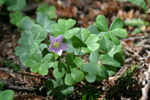
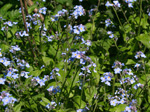
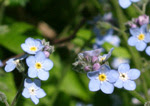
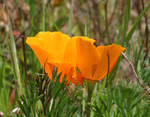
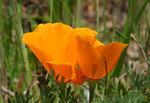
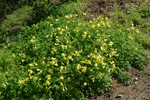
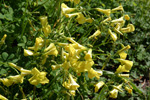
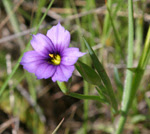
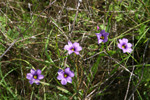
And then of course there were the flowers…
